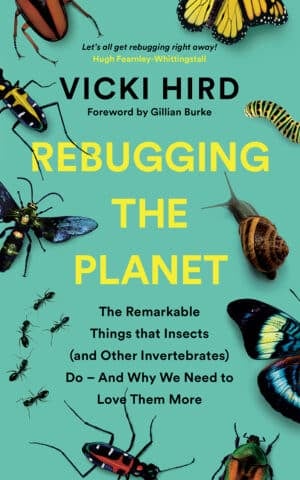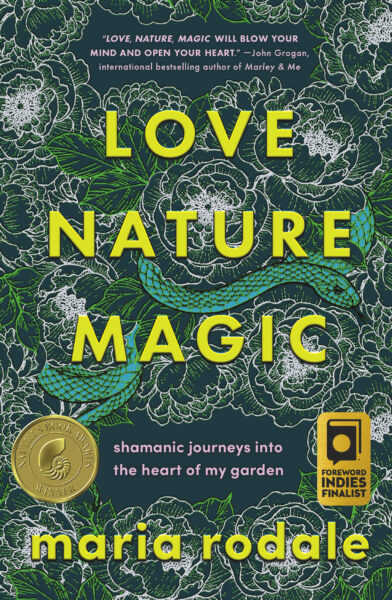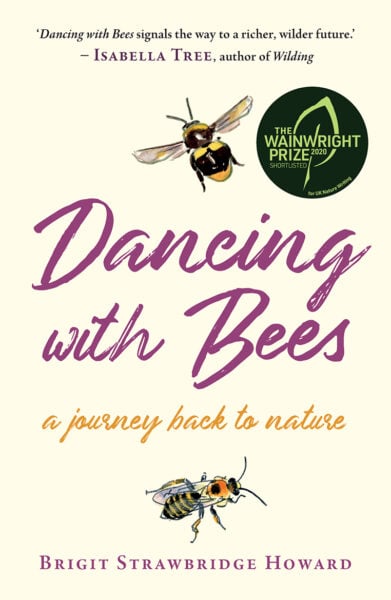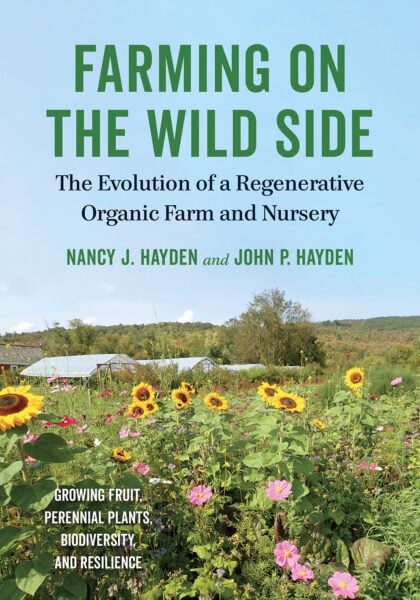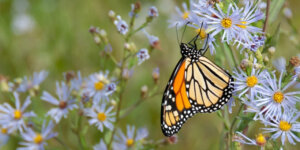How to Rebug Your Neighborhood
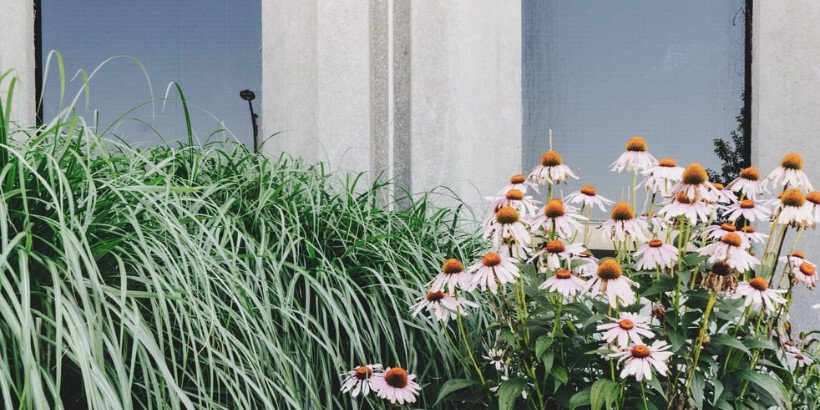
If you’re not a fan of insects, adding more bugs to your neighborhood may sound like a bad thing, but it’s really not! Bugs play a huge role in maintaining an ecosystem and without them, things would start to look pretty grim. Follow these tips for making your neighborhood more bug-friendly, and play your part in rebugging the planet!
The following is an excerpt from Rebugging the Planet by Vicki Hird. It has been adapted for the web.
Rebugging Your Community
Local green patches can really surprise you. I am fortunate to have a wonderful community orchard close by and I visit often to see what I can spot. For the first time in my life, in 2020, I came across a red-belted clearwing moth. I was following a speckled wood butterfly and as it settled on an apple the clearwing moth caught my eye with its distinctive black-bordered but clear wings and a thick, dark body with a single red band. I could not stop telling everyone I knew and sharing the photos I managed to take.
During the 2020 Covid-19 England lockdown, I found huge pleasure in taking far more time during the day to explore the local green spaces and also search for what is finding a home or food in our tiny patch of garden. Alongside hundreds of snails, I have counted over ten bee species and many smaller leafhoppers and shield bugs, weevils, wolf and jumping spiders, caterpillars and hoverflies, and even a large yellow-striped ichneumon wasp. My garden hums from March onwards.
Urban Rebugging
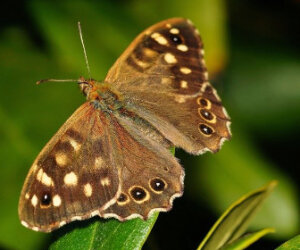 Rather than seeing urbanisation as something that accelerates the loss of nature and wildlife, it should be a vital tool for both helping conserve biodiversity but also, crucially, connecting people with nature. And research shows that it is the amount of green vegetation as well as the variety of plants across different areas that are important in terms of the number and variety of invertebrates you find.
Rather than seeing urbanisation as something that accelerates the loss of nature and wildlife, it should be a vital tool for both helping conserve biodiversity but also, crucially, connecting people with nature. And research shows that it is the amount of green vegetation as well as the variety of plants across different areas that are important in terms of the number and variety of invertebrates you find.
Most of us will be able to find a patch of greenery nearby. It could be just a windowsill with pots, a garden or yard, a small grassy verge, a pocket park or, for the incredibly blessed, a huge park or the countryside.
For those living in urban settings with no garden, parks and green spaces are how they experience the outdoors. They are also vital for the bugs. These spaces will be full of bugs or an ideal site for a bit of rebugging. These green spaces are precious. They are vital not only for human recreation and well-being but for protecting wildlife and, when it comes to the smallest urban spaces, they are often best suited to the invertebrates. We need all these spaces and more to reverse the big decline in invertebrates as they can provide eating, nesting and breeding sites, and corridors for travel.
Addressing Biodiversity
Recent investigations have looked more closely at the role of urban and recreation spaces in addressing the crises in biodiversity, and these suggest we should be providing more space for nature wherever it can be found and not purely in highly protected reserves.1 Surprisingly, they reveal that urban green spaces and infrastructure can provide for an essential part, or the whole, of an invertebrate’s life cycle.
By providing habitats for nests or egg laying, food sources and corridors along which animals can travel, green spaces can let nature thrive. They can also provide a refuge for some species which have been driven out of the countryside by monoculture and heavily treated crops. Invertebrates in turn will give back. They will deliver essential services for the green spaces, including pollination, nutrient cycling, seed dispersal, soil managing and providing food for species up the chain, such as birds and mammals. And some joy, too. Who does not like to see a butterfly?
But how many people understand how vital that green patch is for the small, essential creatures in our lives? How many of us look closely and see what thrives when it’s able to, in the grass, the flower beds or in the trees and shrubs?
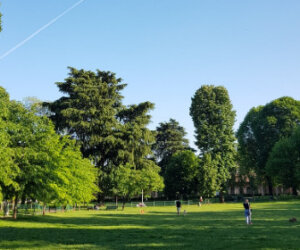 Rebugging to Manage Weeds
Rebugging to Manage Weeds
In urban areas, grass verges are sprayed with herbicide to clear weeds, and the building of houses, roads and business parks covers habitats with concrete. These are all part of the decline in habitats that invertebrates need to feed in, find mates, lay eggs in and find shelter.
There is now, however, a growing movement to urge councils to use less harmful and more nature friendly tools to manage weeds and to reconsider even whether such control is always needed. In the past, councils were often under pressure to keep grounds, verges and parks weed free to avoid complaints about messy areas and the risks of stings or slipping on wet vegetation, for instance. But, with more public awareness, there is greater support for wilder places, and weeds that look great and encourage biodiversity.
Complaints about stinging nettles or weedy mess need to be mitigated but the sight of flowers and bees flourishing on road verges and in parks, when weedkiller or mowing is reduced or removed, can help with public education. Pesticide Action Network groups across the globe are running Pesticide Free Town initiatives to show how zero chemical controls can be adopted.2 Even the UK government’s Highways Agency, which manages road maintenance, has got on board by announcing at the end of 2020 that the hundreds of miles of road verges they manage will be allowed to let wildflowers to thrive, creating vital habitat for insects and other wildlife.3
Best for Bees
Bees thrive in urban areas. They may even thrive better in urban spaces than the countryside due to the diversity of plants and possibly less exposure to chemicals. The bees provide extremely important pollination services for the plants in urban areas, but they need to be able to find a good food source and to be able to locate their hives safely.
One study in Philadelphia in the US, looked at the food sources used by honeybees housed in rooftop apiaries, by measuring the pollen brought back by bees and the weight of the colonies over time. They found that trees, shrubs and woody vines are among the top food sources for honeybees in that city. The bees needed different plants in different seasons. Key overall were the importance of flowering trees and the need to maintain weedy spaces, which can quickly fill with valuable flowering plants.
Spaces for Bugs
There are many spaces that, with a bit of effort and ongoing care, can be rebugged – any place where there is space for nature, however small, including the following:
- derelict land and wasteland
- public parks, squares and gardens
- cemeteries, peri-urban land (the land adjacent to an urban area)
- private and shared gardens of any size
- green verges and pavements with green
- patches and trees
- golf courses and horse paddocks
- sports and training grounds
- buildings with outdoor spaces – e.g. cafes,
- roofs and car parks – where there is an opportunity to plant some greenery or host a beehive or bug hotel
Involve your local communities and institutions using local media, resident groups and social media like local Facebook groups. If more people are allowed and encouraged to adopt a green verge or space in their street, that will create a diverse area that is attractive to worms and other bugs. Companies and institutions could support offices, retail and eating areas, and other places to become more bug friendly with a few simple actions and a bit of regular effort.
Notes
1. Luis Mata et al., ‘Conserving Herbivorous and Predatory Insects in Urban Green Spaces’, Scientific Reports 7 (January 2017): 40970, https://doi.org/10.1038/srep40970.
2. ‘Pesticide-Free Towns Campaign’, Pesticide Action Network UK, https://www.pan-uk.org/pesticide-free/.
3. ‘Breaking New Ground with Eco Drive to Bring the Country’s Verges to Life’, Highways England, 2 December 2020, https://www.gov.uk/government/news/breaking-new-ground-with-eco-drive-to-bring-the-countrys-verges-to-life.
Recommended Reads
Recent Articles
For too long, bugs have had a negative connotation associated with them. But what if we took the time to observe the benefits of insects? It’s time to rebug our gardens, lawns, and parks! The following is an excerpt from Rebugging the Planet by Vicki Hird. It has been adapted for the web. Adding Bugs:…
Read MoreAsparagus is a delicious vegetable with a layered history. How did this aspiring spear make its way from growing in the wild to appearing on our plates? The following is an excerpt from the The Seed Detective by Adam Alexander. It has been adapted for the web. “Nature gives us the key to every secret…
Read MoreChances are, you’ve seen cattails growing on the edge of your local lake or stream at least once or twice. Instead of just passing these plants, try foraging for and cooking them to create delicious seasonal dishes! The following excerpt is from The New Wildcrafted Cuisine by Pascal Baudar. It has been adapted for the…
Read MoreGarlic mustard: while known as “invasive,” this plant can be consumed in its entirety and has great nutritional value. Plus, the garlic-flavor is a perfect addition to any recipe that calls for mustard! The following are excerpts from Beyond the War on Invasive Species by Tao Orion and The Wild Wisdom of Weeds by Katrina…
Read MorePeregrine falcons, while known as predators, are essential to our environment. These stunning birds have a rich history, an interesting present, and an uncertain future. The following is an excerpt from Feather Trails by Sophie A. H. Osborn. It has been adapted for the web. Who Are Peregrine Falcons? Though relatively uncommon wherever it occurs,…
Read More

